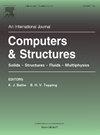Geometrically nonlinear isogeometric topology optimization via extended finite element method
IF 4.8
2区 工程技术
Q1 COMPUTER SCIENCE, INTERDISCIPLINARY APPLICATIONS
引用次数: 0
Abstract
Geometric nonlinearity can accurately simulate and predict the large deformation behavior of structures, which is crucial for ensuring the safety and reliability of engineering designs. To address the limitations of existing linear isogeometric topology optimization methods in accurately describing the nonlinear behavior of boundary elements, this paper proposes a geometric nonlinear isogeometric topology optimization method based on the extended finite element method. Firstly, to accurately capture the nonlinear behavior of boundary elements, Gaussian integration points and weights of boundary elements are regenerated during the optimization process using the extended finite element method. Secondly, an isogeometric topology optimization model is developed based on the principle of minimum complementary work and the bi-directional evolutionary structural optimization method. A geometric nonlinear isogeometric analysis in the total Lagrangian formulation is proposed, and the incremental form of the Newton-Raphson method is employed to solve the nonlinear equilibrium equations, improving the accuracy and stability of structural response analysis. Lastly, the effectiveness and necessity of isogeometric topology optimization considering geometric nonlinearity are demonstrated through 2D and 3D examples. The results show that structures experience significant deformation under full load conditions, leading to the failure of linearly optimized structures, while geometrically nonlinear optimized structures exhibit superior performance.
基于扩展有限元法的几何非线性等几何拓扑优化
几何非线性可以准确地模拟和预测结构的大变形行为,对保证工程设计的安全可靠至关重要。针对现有线性等几何拓扑优化方法在精确描述边界元非线性行为方面的局限性,提出了一种基于扩展有限元法的几何非线性等几何拓扑优化方法。首先,为了准确捕捉边界元的非线性行为,采用扩展有限元法在优化过程中重新生成边界元的高斯积分点和权值;其次,基于最小互补功原理和双向进化结构优化方法,建立了等几何拓扑优化模型;提出了全拉格朗日公式中的几何非线性等几何分析方法,并采用增量形式的牛顿-拉夫森方法求解非线性平衡方程,提高了结构响应分析的精度和稳定性。最后,通过二维和三维算例验证了考虑几何非线性的等几何拓扑优化的有效性和必要性。结果表明:结构在全荷载条件下变形较大,线性优化结构破坏严重,而几何非线性优化结构表现出较好的性能;
本文章由计算机程序翻译,如有差异,请以英文原文为准。
求助全文
约1分钟内获得全文
求助全文
来源期刊

Computers & Structures
工程技术-工程:土木
CiteScore
8.80
自引率
6.40%
发文量
122
审稿时长
33 days
期刊介绍:
Computers & Structures publishes advances in the development and use of computational methods for the solution of problems in engineering and the sciences. The range of appropriate contributions is wide, and includes papers on establishing appropriate mathematical models and their numerical solution in all areas of mechanics. The journal also includes articles that present a substantial review of a field in the topics of the journal.
 求助内容:
求助内容: 应助结果提醒方式:
应助结果提醒方式:


